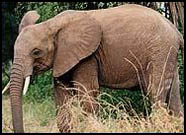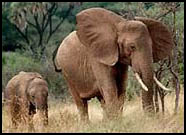THE ELEPHANTS OF AFRICA reveals some lesser-known, yet equally important populations that inhabit diverse environments of the continent, from the thick rain forests of the Congo Basin to the parched deserts of Namibia. Researchers have determined that the smaller forest elephants, Loxodonta africana cyclotis, are a distinct subspecies from their savannah cousins of East Africa, Loxodonta africana africana. However, the data suggest that desert elephants are actually savannah elephants who have adapted to the rugged lifestyle of the barren desert.
An adult male savannah elephant — the largest land mammal in the world — weighs about 12,000 pounds and stands roughly 10 feet tall at the shoulder. The smaller forest elephant weighs 10,000 pounds at most. And unlike savannah elephants’ curved tusks, forest dwellers’ are small and straight, designed for negotiating routes through dense foliage. Both elephants do possess the same tough hide (the Latin name for elephant is “pachyderm,” or “thick-skinned”). But while their skin may be durable, elephants still need protection from insects and the hot African sun. Wallowing in a mud bath cools down an elephant as well as provides an extra layer of cover.
Regardless of where elephants live, their social behaviors and social structures remain largely the same. Cynthia Moss has dedicated her life to understanding the biology, ecology, and society of the herds that roam the savannahs of Amboseli National Park in Kenya. Here, in the open landscape, biologists can spot a group miles away and approach by car to observe. From their vehicles, Moss and her colleagues in East Africa have unlocked the mysteries of how these enormous animals learn as youngsters, raise their young, survive as adults, and communicate with family members.
The mother receives help from aunts, sisters, and cousins who serve as nannies. Known as “allomothers,” these baby-sitters are young female elephants learning how to care for babies. Teaching a potential mother how to rear her child is an important task, since the calves’ survival depends on it. And since elephants bear young only once every few years, each baby is essential to the herd’s ultimate survival.
After five years of rearing this young elephant, the mother gives birth to a new infant, weaning the now adolescent calf at the same time. By then, the young elephant weighs nearly a ton and has learned how to forage on available vegetation. Males tend to leave their mothers earlier than females, with young bulls beginning to wander beyond the protective family circle at the early age of six.
As a young elephant grows, it learns how to become independent by watching and mimicking others. A calf will begin to experiment with its trunk, using it to grasp grass and other solid food, at about four months of age. But it takes a lot of practice to master the more than 40,000 muscles that give an elephant’s long snout so much dexterity.









